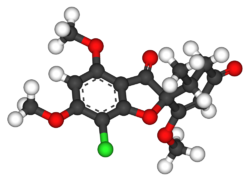 | |
 | |
| Clinical data | |
|---|---|
| Trade names | Gris-peg, Grifulvin V, others |
| AHFS/Drugs.com | Monograph |
| MedlinePlus | a682295 |
| Pregnancy category |
|
| Routes of administration | By mouth |
| ATC code | |
| Legal status | |
| Legal status | |
| Pharmacokinetic data | |
| Bioavailability | Highly variable (25 to 70%) |
| Metabolism | Liver (demethylation and glucuronidation) |
| Elimination half-life | 9–21 hours |
| Identifiers | |
| |
| CAS Number | |
| PubChem CID | |
| DrugBank | |
| ChemSpider | |
| UNII | |
| KEGG | |
| ChEBI | |
| ChEMBL | |
| CompTox Dashboard (EPA) | |
| ECHA InfoCard | 100.004.335 |
| Chemical and physical data | |
| Formula | C17H17ClO6 |
| Molar mass | 352.77 g·mol−1 |
| 3D model (JSmol) | |
| |
| |
| (verify) | |
Griseofulvin is an antifungal medication used to treat dermatophytoses (ringworm). [1] [2] This includes fungal infections of the nails and scalp, as well as the skin when antifungal creams have not worked. [3] It is taken by mouth. [2]
Contents
Common side effects include allergic reactions, nausea, diarrhea, headache, trouble sleeping, and feeling tired. [2] It is not recommended in people with liver failure or porphyria. [2] Use during or in the months before pregnancy may result in harm to the baby. [2] [3] Griseofulvin works by interfering with fungal mitosis. [1] [2]
Griseofulvin was discovered in 1939 from the soil fungus Penicillium griseofulvum . [4] [5] [6] It is on the World Health Organization's List of Essential Medicines. [7]